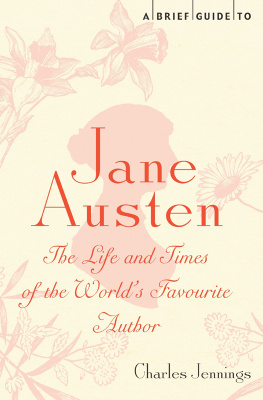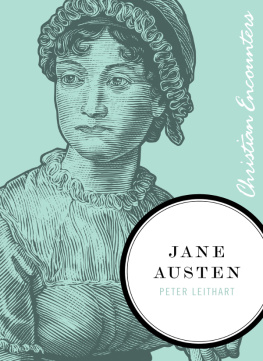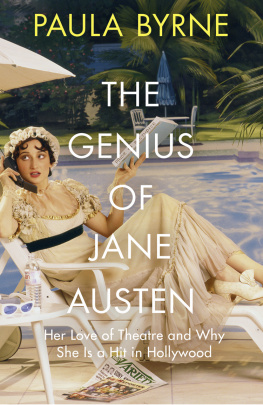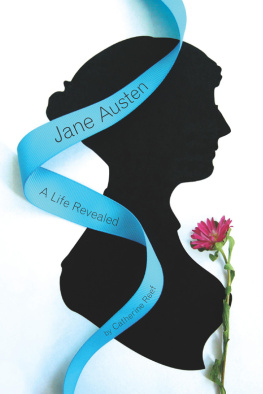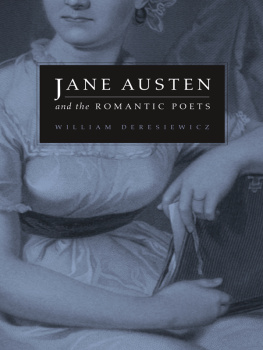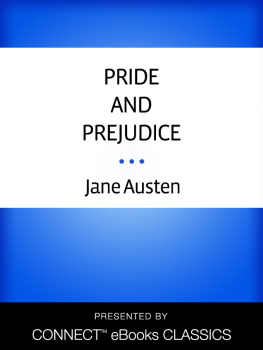Charles Jennings studied English at Oxford and then became, as reported in the Spectator, the funniest journalist in London. He has written numerous books, including a history of Greenwich, as well as Them and Us: The American Invasion of English High Society (2007).
Recent titles in the series
A Brief Guide to the Supernatural
Leo Ruickbie
A Brief Guide to Star Trek
Brian J. Robb
Star Wars
The Unauthorised Inside Story of George Lucass Epic
Brian J. Robb
A Brief Guide to Secret Religions
David Barrett
A Brief History of Angels and Demons
Sarah Bartlett
A Brief History of Bad Medicine
Robert Youngston
A Brief History of France
Cecil Jenkins
A Brief History of Slavery
Jeremy Black
A Brief History of Sherlock Holmes
Nigel Cawthorne
A Brief History of King Arthur
Mike Ashley
A Brief History of the Universe
J. P. McEvoy
A Brief History of Roman Britain
Joan P. Alcock
A Brief History of the Private Life of Elizabeth II
Michael Patterson
A BRIEF GUIDE TO
JANE AUSTEN
CHARLES
JENNINGS

Constable & Robinson
5556 Russell Square
London WC1B 4HP
www.constablerobinson.com
First published in the UK by Robinson,
An imprint of Constable & Robinson, 2012
Copyright Charles Jennings 2012
The right of Charles Jennings to be identified as the author of this work has been asserted by him in accordance with the Copyright, Designs and Patents Act 1988
All rights reserved. This book is sold subject to the condition that it shall not be reproduced in whole or in part, in any form or by any means, electronic or mechanical, including photocopying, recording, or by any information storage and retrieval system now known or hereafter invented, without written permission from the publisher and without a similar condition, including this condition, being imposed on the subsequent purchaser.
A copy of the British Library Cataloguing in
Publication data is available from the British Library
ISBN 978-1-78033-046-4 (paperback)
ISBN 978-1-78033-047-1 (ebook)
1 3 5 7 9 10 8 6 4 2
First published in the United States in 2012 by Running Press Book Publishers,
A Member of the Perseus Books Group
All rights reserved under the Pan-American and International Copyright Conventions
Books published by Running Press are available at special discounts for bulk purchases in the United States by corporations, institutions, and other organizations. For more information, please contact the Special Markets Department at the Perseus Books Group, 2300 Chestnut Street, Suite 200, Philadelphia, PA 19103, or call (800) 810-4145, ext. 5000, or email .
US ISBN 978-0-7624-4629-2
US Library of Congress Control Number: 2011942359
9 8 7 6 5 4 3 2 1
Digit on the right indicates the number of this printing
Running Press Book Publishers
2300 Chestnut Street
Philadelphia, PA 19103-4371
Visit us on the web!
www.runningpress.com
Typeset by TW Typesetting, Plymouth, Devon
Printed and bound in the UK
CONTENTS

INTRODUCTION
Jane Austen is so well-known, her novels so central to literary culture, why does one need a guide? After all, Mr Darcy, Emma Woodhouse, Mr Collins and Fanny Price are such familiar presences that we use them as conversational shorthands; while Pemberley has turned into a destination as fixed in the popular consciousness as Daphne du Mauriers fictional estate Manderley, or Evelyn Waughs Brideshead. And everyone thinks they can recognize her prose when they see it, especially the opening lines of Pride and Prejudice.
But for all her popularity, all her acknowledged genius its not as easy to dive straight into one of Jane Austens novels as it is with the works of, say, Charles Dickens or Mark Twain. Her apparent modernity her cool ironies, her sense of place, and her wit can be misleading. The two hundred years between her society and ours are a real gap, and some sort of background is useful, however well we think we know the landscape. Miss Austen, too, needs introducing. Few writers are so well loved by their readerships; but why, exactly?
A Brief Guide examines Jane Austen from three angles. The biographical section is presented as its own narrative, in order to let the shape of her life emerge. After all, the great majority of it was spent in dependent spinsterhood, a very unconsidered existence. Only the last five years offered her the chance to become Jane Austen, the writer, and thus escape the condition that had until then defined her. Her success came late, and in a rush; and I want that shape to be clear. Im also keen to avoid the dreaded biographical fallacy, of tying biographical events too closely to events and characters in the fiction. Physically separating the two seems a good way of keeping history and the creative imagination in their rightful places.
When talking about the novels, Ive done my best to see them from the perspective of the interested contemporary reader, with no particular axe to grind. All the novels present problems, in one way or another, and Ive tried to pick out the most important ones, the ones I think most likely to make the reader scratch his or her head. At the same time Ive tried to identify the good bits, or at least the bits I think are good. Of course, its possible to read just about anything into the works of Jane Austen, including proto-feminism, anti-slavery, problems with the cult of the Picturesque and a critique of the Monarchy. Great novels persistently lay themselves open to interpretations and re-interpretations, and Miss Austens big six are no different. But in A Brief Guide Im less intrigued by the possibility of reading into Sense and Sensibility pretty much whatever you want to read into it, and more interested in the idea that Austens novels are not perfect. There are wrong turns and mis-steps, and the best way to approach her is with a degree of critical caution, acknowledging the fallibilities, and seeing how often she triumphs over them.
The Regency section explains itself a compressed attempt to paint in the social background, answering, along the way, such questions as: what time was dinner, and how many courses were there; how often did people wash; why was Brighton considered so louche; and why does Emma not call Mr Knightley by his first name? Questions, in other words, that might easily come up in the course of reading.
One of the very best ways to spend your time is in reading (or re-reading) all Jane Austens novels in order of publication (which is how Ive dealt with them in the critical introductions) and back to back. I know, because I recently did it, and it was an unusual privilege. Throw in some time with the Letters to Cassandra, and as any Janeite will tell you, you start to feel Miss Austens presence to an uncanny degree, accompanied by a strong desire for her still to be alive, so that you might meet her, quiz her, try to understand her. This may well be untrue of almost any other writer of fiction you can name; but its certainly true for her.
So, to begin: How did she do it?
1
Next page
